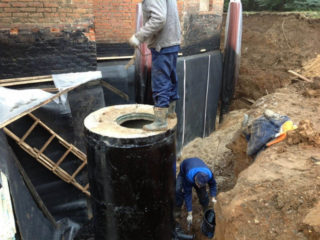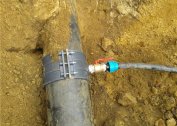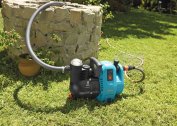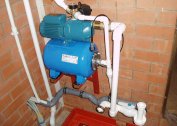In most country houses and cottages, the organization of an autonomous water supply system is an acute issue. A possible solution is drilling and arranging your own source. Gradually, new houses and farm buildings appear, so you need to know the norms of the location of the well on the site.
Regulations
 The distance between the water wells, septic tanks and the house is regulated by a number of regulatory documents:
The distance between the water wells, septic tanks and the house is regulated by a number of regulatory documents:
- Rules for the location of external water supply communications (SNiP 02.04-84).
- Rules for installation and arrangement of sewer systems (SNiP 02.01-85). The requirements for the sanitary protection zone are regulated in the same place.
In accordance with the rules listed in the regulatory documents, it is important to consider the following recommendations:
- The well is located in an ecologically clean place.
- The interval between the well and the septic tank is 50 meters.
- Drilling a well is required above the location of the sump.
- Septic tanks equip at least 5 meters from the edge of the road and apartment building.
- A cesspool breaks out at a distance of at least 4-5 meters from neighboring sites.
If we talk about the relative location in order to prevent exhaustion of sources, a minimum interval should be observed between them. This indicator will depend on the radius of influence. The radius varies, it depends on the dynamic water level in the mine, the degree of water resistance of the aquifer rock and the abundance of the water reservoir.
Basic requirements and norms
 The calculation of the optimal distance between a residential building and sanitary facilities is an important issue from the point of view of preventing the threat of disease and infection of households.
The calculation of the optimal distance between a residential building and sanitary facilities is an important issue from the point of view of preventing the threat of disease and infection of households.
Supervisory authorities when checking the location of a well, bath, cesspool, etc. pay close attention. The basic requirements and the norm of SNiP must be met strictly.
- Individual relaxation and amendment can be obtained only if costly manipulations have been carried out to ensure maximum epidemiological safety.
- The optimal distance, in accordance with sanitary standards, prevents sewage and pathogens from entering a well from a septic tank or cesspool.
- Strict adherence to requirements and norms prevents the likelihood of contamination of the neighboring area, soil, nearby natural reservoirs, as well as a source of drinking water. This favorably affects the well-being and human health.
Compliance with the rules pursued by law makes life easier for the landowner because it minimizes the likelihood of developing diseases.
Accepted Interval Standards
The interval between the residential building and the well varies between 3-7 meters. This difference is due to several factors, the main one is the possibility of maintenance and repair work. Because of these considerations, it is not recommended to build a well in the basement of a residential building.
The use of an artesian source for a considerable time with the help of pumping equipment seems impossible without regular inspection. Much depends on the type of pumping station. Much also depends on natural conditions - the depth of the reservoir and the terrain.
The remoteness indicator is by no means the only parameter that needs to be taken into account when drilling and equipping a well.According to existing requirements, the well should be located not only from buildings, but also from other structures on the site.
- Drilling of the source is prohibited in the immediate vicinity of the motorway and places where cars are parked.
- The interval between the source of drinking water and the chicken coop, any room with animals must be at least 8 meters. Moreover, not only the distance to your home, but also the neighbor’s, is taken into account.
- Near the source within a radius of 5 meters there should not be fruit trees, otherwise, with the growth, the probability that the root system will decay significantly increases.
- The distance from the fertilized beds and the greenhouse is at least 20 meters.
- The optimal interval between the fence and cesspool, well, etc. - 3-4 meters, in some sources you can see a distance of 10 meters.
- A distance of at least 30 meters must be maintained between the well and the septic tank, but if the area of the plot is limited, the interval can be reduced to 15 meters, the gap between neighboring buildings is also taken into account.
In accordance with the requirements of SanPiN, the source of well water should be at a level higher than the cesspool or septic tank. Neglecting this rule will significantly increase the likelihood of water infection.
The consequences of the incorrect location of the well in the area
When starting to drill a well mine, it is important that the aquifer is located at a certain depth at the site of the work. First you need to choose the right site, which has enough free space for the entrance and operation of the rig.
At times, the search for aquifers is difficult. Pay attention to the following natural phenomena:
- Species of plants growing on the site.
- Features of the geological structure.
- At what level are surface groundwater.
Sometimes it is required to conduct additional test or exploratory drilling.
If the source is incorrectly positioned, this promises the appearance of a large number of problems. The main ones are:
- Increased financial investment through the purchase of more powerful pumping equipment and a hydraulic accumulator.
- Unreasonable increase in the cost of laying a water supply system.
- The likelihood of damage to the well or elements of its arrangement increases.
The maximum distance from the well to the house according to SNiP is 7-10 meters. This is the optimal distance, but provided that no gas lines or power cables are laid in the immediate vicinity of the water intake point.
Responsibility for non-compliance with SNiP
Drilling and construction of a well in a suburban area must comply with all construction standards and legislative sanitary rules.
Particularly acute is the question regarding cesspools, which need careful and specific care. Any kind of sewage pit or septic tank should be cleaned with a sterilizing mixture. The composition of the washing solution includes acids and other components. Preliminarily, all sewage is pumped out by the scavenger.
If violations of sanitary rules have been noted, a fine is issued, and in case of systematic failure to comply with the requirements, a court order may be issued and the source, cesspool or septic tank should be removed from the site.
Experts note that if you properly drill and equip the source, find suitable equipment and maintain it, the service life reaches 50 years or more.



